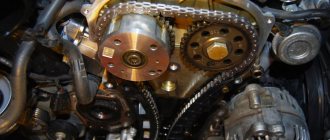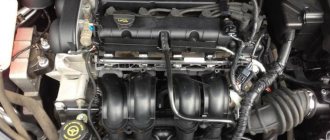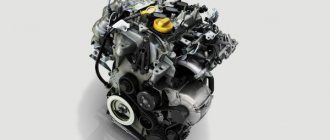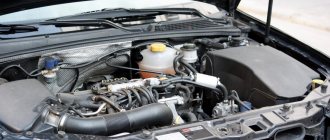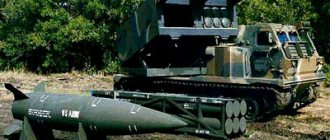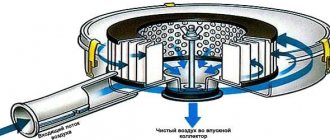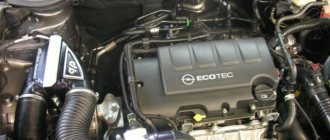In 2005, the VAG concern began equipping its cars with engines of the EA111 family. Until 2009, this family consisted of turbocharged 1.4-liter engines, a naturally aspirated 1.6 FSI, and then they were joined by a 1.2-liter turbo engine. But the problems of all these engines are common, except that the aspirated engine does not concern troubles with turbine malfunction.
The most common engine in the EA111 family is the 1.4-liter turbo engine. There are about 10 of its modifications, and power varies from 112 hp. (CAXA) up to 180 hp (CAVE, CTHE). All versions, whose power does not exceed 140 hp, are equipped with one turbocharger. 1.4-liter TSI/TFSI engines with 140-180 hp. equipped with both a turbocharger and a drive compressor. Let's look at typical and very expensive problems with a 1.4-liter engine using the example of its basic and very common CAXA version (122 hp).
Valve train chain
The timing drive of the 1.4 TSI CAXA engine is carried out by a chain. The chain turned out to be very short-lived. It must be changed at intervals of 80,000 km. Replacing the timing chain (with installation of a repair kit) will cost about 1000 rubles. If you need to replace the crankshaft sprocket and phase regulator, the price will double. Why do you have to change the chain? It simply stretches over time. The VW concern blamed the chain supplier for this - they say they did not make it well enough.
Stretching the timing chain can cause it to jump, which ultimately leads to the death of the engine: the valves hit the pistons. However, this trouble can be predicted. The fact is that if the chain is overstretched, the 1.4 TSI CAXA engine rattles and chirps immediately after starting. If a suspicious sound appears immediately after starting the engine, you should make an appointment to replace the chain.
However, the chain in the 1.4 TSI CAXA engine can jump without stretching it. The fact is that the chain tensioner in this engine is very poorly designed. The tensioner plunger performs its function - it extends the tensioner bar - only when there is operating oil pressure. When the engine is stopped, there is no oil pressure, and nothing prevents the tensioner plunger from loosening the stop. Moreover, the 1.4 TSI CAXA engine simply does not have a mechanism for blocking the counter-travel of the plunger. Therefore, every owner of a car with a 1.4-liter VAG engine knows that it is impossible to leave it in gear while parked. In this case, the chain will stretch, move the bar and plunger and will literally hang on the timing sprockets. When starting the engine, the chain will easily jump 1-2 teeth, which will be enough for the pistons to hit the valves. Sagging of the timing chain of the 1.4 TSI CAXA engine also occurs when trying to start the car while towing or while replacing the clutch. There have been cases that after installing a new clutch (both on a manual transmission and on a DSG), it was necessary to resort to replacing the motor, which “died” at the same service station immediately after turning on the starter. Due to negligence or ignorance of this feature of the 1.4 TSI CAXA engine, people encountered problems even after driving literally 10,000 km or a short time after replacing the timing chain repair kit. If a 1.4-liter engine fails due to timing chain stretching, then it is more profitable to buy a contract unit and replace it. The cost of the contract 1.4 TSI CAXA engine reaches 1,800 rubles. But during replacement, you should immediately inspect and evaluate the condition of the timing chain and, if necessary, update it too.
These problems with 1.4-liter engines of the EA111 family are known all over the world and are of the same nature.
Are TSI motors reliable? We talk with experts
Cars with modern turbocharged petrol engines are becoming increasingly popular in Belarus. We’ll talk to the employees of a specialized service station about how these engines have proven themselves, what problems may arise with them, and whether it’s worth buying cars with TSI. TSI engines are turbocharged petrol engines with direct fuel injection. The abbreviation TSI originally stood for Twincharged Stratified Injection, which can be translated as “double supercharging layer-by-layer injection.” Then the abbreviation TSI began to stand for Turbo Stratified Injection, without specifying how many compressors are used for supercharging - two or one. It is noteworthy that the Audi company, along with Volkswagen, part of the VAG concern, designates engines of this design as TFSI, where F stands for Fuel. Over the past two years, Audi, Skoda, Volkswagen and Seat have been switching to a new range of TSI engines. But what about the reliability of the “old” TSI 1.2 and 1.4 liters, which are very popular in the secondary market? To find out, we turned to the Pit Stop Motors service station, which specializes in the repair and maintenance of VAG cars. We are advised by the service station manager Andrei ANTILEVSKY and master mechanic Alexander GESHELEV. — How do you assess the reliability of TSI engines? Do owners of cars with these engines often come to you with problems? “At the moment, such motors are becoming quite common, so people come to us with them more and more often. Cars with 1.2 TSI and 1.4 TSI have recently simply poured into our market. In Europe, dealers often greatly increase the service interval. We recommend changing the oil every ten thousand. By the way, this applies to any engines, not just TSI. For example, the owner gives us a car imported from Germany for repair. We look at the service book, and there the first oil change took place at 60 thousand kilometers, the second at 120 thousand, you can immediately put a tick in front of the client, knowing that after some time he will come for a certain list of work. Of course, with such a maintenance interval the engine will last until the end of the warranty. But then the engine life is in question. It is from here, as it seems to us, that all the “horror stories” around TSI engines “grow”. If the service book states that the oil was changed every 15 thousand kilometers, then this car drives and does not break down. So if you carry out maintenance on time, there should be no problems with such a motor. If you compare the reliability of used cars purchased here with those imported from Europe, then most often problems arise with imported cars. This is due to the increased service interval in European countries, and the mileage there is usually quite long.
| In the new 1.2 and 1.4 TSI engines of the EA211 series, the timing drive is now carried out by a toothed belt - there are no longer “chain” problems |
— It is believed that the Achilles heel of these engines is the timing chain drive. Is it really? — Yes, at the moment this is really the main problem with engines of the old TSI series. It is associated both with the unreliability of the timing chain tensioner and with premature wear and stretching of the chain, due to which the chain can jump over the teeth of the sprockets, thereby “ensuring” the “meeting” of the pistons and valves. However, this is normal routine work. The toothed belt also changes, only TSI chains do not have replacement regulations for this - problems can arise even after 50 thousand kilometers. If the owners hear extraneous sounds, they contact us and come in the worst case, when time is lost, the cars are pulled in by a tow truck. Then we look at the engine: if a large unit is damaged, then sometimes it is more profitable to replace the engine than to carry out repairs. The original cost of the cylinder head is comparable to the cost of the engine - about $3,000. Many spare parts are not yet included in the “license”, so only the “original” is suitable. So it turns out that it is more economically feasible to replace the engine than to repair it. However, chain stretching, in addition to the small engines of the EA111 1.2 TSI, 1.4 TSI series, also applies to the 1.8 TSI and 2.0 TSI engines. You need to hear the car: if there is a crackling sound, it is better not to take it to the extreme. The main thing here is to hear on time and arrive on time. There is no big problem with this; it is not that expensive to change the chain. If we talk about V6 engines, then replacing the chain is very expensive. We have to remove the entire unit; there are several chains in the motor. — How often did it get to the point where, as a result of the destruction of parts of the 1.2 TSI and 1.4 TSI engines, it was necessary to change the engine? — With small cars, we recorded only one case with the Volkswagen Polo 1.2 TSI. They brought it to us with a destroyed engine. But again, the human factor played more of a role here: there was a crackling noise in the engine before it broke down, but the owner did nothing about it. The engine stopped starting, they tried desperately to start it: they turned the starter, pushed it. As a result, the valves broke, the piston fell apart, and “scuffs” appeared on the cylinder wall. The repair was deemed impractical, so the power unit had to be replaced with a used one. Moreover, it was not immediately found; it cost a pretty penny - it cost about $3,000. And so basically, timing chain slip has so far been managed with repairs, as a rule, replacement of the chain itself and repair of the cylinder head.
| When servicing older TSI series engines, the main attention should be paid to the timing chain drive |
— What advice can you give to owners of cars with TSI engines?
— We do not recommend leaving the car in gear without a handbrake. If the car moves backwards in gear, there is a very high probability of the chain slipping. It’s better not to experiment, especially if there were some extraneous sounds before. But people are also interesting. You see, when a car is under warranty and some issues arise with it, they are quickly resolved - the service immediately changes everything. But we cannot force anyone. For example, a man came to us for an oil change. We strongly recommended servicing the timing drive, as a cracking noise was clearly audible in the engine. If you raise orders now, they indicate: “replacement of the timing chain is recommended.” And the owner of this car drove like this for a very long time, but everything seemed to end well - he finally changed the chain. Therefore, the main advice is to look after the car, do not skimp on consumables and listen to the engine. — Besides the chain, the second problem is high oil consumption? - Yes, there is such a problem. It even happened that oil was thrown onto the candles. But not enough cases were recorded to talk about TSI problems specifically. This has also been noted on other modern engines with high mileage. — Are there any problems with supercharging? — There were no serious problems. Usually, issues arise with the control and tightness of the system; the compressors themselves are rarely rejected. Although in TSI gasoline engines the load on the turbocharger is quite large, no major issues have arisen here so far. — Does the direct fuel injection system cause any problems for owners? — There were no problems with the fuel injection itself; the injectors were changed only a couple of times. In the first case, the car was imported from America - it was all corroded, the second car was also rusty. The injectors somehow became corroded and had to be replaced. It seems that there was water in the tank of these cars. — What other faults were recorded in TSI? — There were problems with engine coking: the oil receiver became clogged with coking particles. If the oil pressure light comes on at least once in some modes, then it is better to play it safe. This comes down to maintenance and operating modes - in many respects, we emphasize, the human factor plays a role here. In such cases, the pan is removed, the oil and filter are changed, and the lower part of the engine is cleaned. It varies in different cars. In 1.8 turbocharged engines, it happens that the valves themselves become coked. High engine speeds - crankcase ventilation fails, oily air ends up on the intake valves. The valve cannot fully adhere to the seat - compression decreases. In such cases, either replace or clean the cylinder head. If there are problems with the phase regulators, again everything depends on the circuit. When it stretches, the tensioner stops working normally and the phases begin to “jump.” But everything changes here in an elementary way. When an error occurs, the regulator has to be changed one out of ten times, which is not so often. The problem may be in both the control system and the actuators. TSIs do not like short trips, especially in the cold season. Engines take quite a long time to warm up; often it does not reach the full warm-up cycle due to short trips. By the way, we recommend changing spark plugs more often if the car is operated over short distances. In this regard, TSIs are somewhat whimsical. — Is it worth buying a car with TSI in our conditions? What to look for when buying a used 1.2 TSI and 1.4 TSI? — You can safely buy a new car with these engines. Progress is being made, the manufacturer is eliminating weak points. As for used cars, it all depends on how they were used and what the mileage was. However, this is also true for other cars. TSI is actually not as scary as they say it is. The most important thing is to listen to extraneous sounds. But again, the sounds usually appear when the engine is cold or after a long period of parking. If, when inspecting the car when the engine is already warm, sounds are heard, you need to keep in mind that there may be problems with the car. Computer diagnostics will not be superfluous either. Surveying data from electronic drives can indicate errors in valve timing adjustment and often shows a mismatch between the camshaft and crankshaft marks. This can be either an “electronic” error or a “mechanical” one. You will only find out about oil consumption and everything else when you buy the car. It is quite difficult to fully diagnose an engine, and errors can always be erased. Unfortunately, no one is insured here, so we advise you to look for a car with a transparent service history. After purchasing a used car, it is important not to skimp on maintenance, listen to the engine and not push the tachometer into the red zone. Cars with TSI engines, subject to proper operation, it seems to us, can travel 300-400 thousand kilometers without any problems. It is clear that some work will have to be done, as a rule, closer to 200 thousand. After all, what the drivers brought here were cars with huge mileage. However, it happens that even at 120 thousand kilometers problems arose with TSI. No one is immune from this. New TSI line of EA211 and EA888 series - working on bugs? In 2013, the VAG concern introduces new gasoline engines of the EA211 series. The range of turbo-petrol engines of the new series includes 1.2 TSI, 1.4 TSI (EA211 series), 1.8 TSI and 2.0 TSI (EA888 Gen.3 series) engines. As you can see, the volumes are the same, but the hardware is now completely different - the new TSI motors have become structurally different compared to the old EA 111 and EA888 (Gen.2). So, all engines received 4 valves per cylinder, in addition, many parts “lost weight”. In total, the engines lost approximately 22 kg. The turbine and exhaust manifold integrated into the cylinder head have now been moved back. The MQB platform required the same arrangement of motors in the engine compartment - many fastenings were unified. The power units are now installed at the same angle of 12 degrees - this measure combines several other advantages: a shorter front overhang is obtained and the interior layout is improved. Engines 1.2 and 1.4 series EA211 have lost the timing chain, the drive is now carried out by a toothed belt. Nevertheless, in the EA888 engines the chain drive was retained, and the cylinder block was still cast from cast iron. Among the innovations are a double cooling system, a cylinder head combined with an exhaust manifold, a “water” intercooler, and the ability to turn off two cylinders when driving with partial load at frequencies of 1400-4000 rpm. However, listing all the innovations is a matter for a separate article. The fact is that Volkswagen tried to eliminate a number of problems inherent in the “old” TSI. This includes a long warm-up in the cold, a capricious chain, and a high load on the turbocharger. However, it is obvious that the focus was on reducing weight, size and fuel consumption. New cars have a fairly dense arrangement of units, and integrated components are widely used. How will all this work in our conditions? Wait and see. Yuri GLADCHUK. The editors would like to express their gratitude to the Pit Stop Motors service station for their assistance in preparing the material. Opinions of owners of cars with TSI engines “I have a Golf Plus 1.4 TSI 122 CAXA, 2008 (model 2009). The mileage is 207,000 kilometers. There were no problems with the engine specifically, with the exception of a crackling sound when starting the engine. As I understand it, this is a “disease”, in particular, of this model range. I changed the timing chain for the first time at 110,000 miles, along with the regulator and gear, in short, to the fullest. The second time, with a mileage of 206,000, I only changed the chain and tensioner with guides and stabilizer - everything cost quite a budget, somewhere around $470. If you are interested in the rest: at 130,000 km I changed the air conditioning compressor (again, I found out on the forum that this is a rather problematic area); At 145,000 km it was the turn of the pump and the V-belt pulley. And so the engine runs like a clock, there are no problems with the operation of the turbine. However, in winter the car warms up slowly, but if there are heated seats, then this is not a problem.” “I also have 1.4 for 122 horses.” Mileage - 76 thousand. When starting it sometimes crackles, I think in a month I will change the chain with the regulator. Otherwise, the engine is nothing but pleasing.” “I’ll also add: before buying a car with this engine, I read on the forum that this engine loves oil: up to 500 g per 1000 km. When I picked up the car from the dealership, I even bought 1 liter of branded Long Life3 from the dealer. The dealer representative swore that this was the oil that was poured at the factory for the first time, so to speak, “break-in”. So, now the mileage is 36 thousand, two maintenances have passed, and during this time the engine has not consumed a single gram of oil. I don’t drive like a pensioner, but I try not to shake the whole soul out of the engine when accelerating.”
Intolerance to low-quality gasoline
Of course, any engine prefers high-quality fuel, but this is a different story. Due to low-quality fuel, carbon deposits appear on the fuel injectors, which are located in the combustion chamber of the 1.4 TSI CAXA engine - the injection is direct. Carbon deposits on the injectors change the flow of fuel atomization, which can lead, in the worst case scenario, to burnout of the piston.
In general, the pistons of the 1.4 TSI CAXA engine, which Mahle produced for VW, are quite fragile. And the gasoline injection pressure is very high. And if low-quality fuel gets into the combustion chambers of this engine, then inevitable detonation will very quickly break the small, light and thin-walled pistons. Filling the 1.4 TSI CAXA engine with low-quality fuel quickly leads to burnout of the pistons and destruction of the cylinder walls. In addition, low-quality fuel causes injectors and even the fuel pump to fail.
Also, with low-quality gasoline, the intake valves of the 1.4 TSI CAXA engine become covered with carbon deposits. The point is direct injection, which is not able to clean the intake valves with fuel flow. On engines with distributed injection, passing as part of the fuel mixture along the valve stem and its working surfaces, most of the carbon deposits are washed away and burned in the chamber. But on 1.4 TSI CAXA engines with their direct injection, carbon deposits constantly accumulate on “cold” intake valves. A critical amount of carbon deposits accumulates after a mileage of 100,000 – 150,000 km. As a result, the valves no longer fit tightly to their seats, compression decreases, and the engine begins to run unevenly, loses power and consumes more fuel. Therefore, a fairly common procedure for 1.4 TSI engines is to remove the cylinder head, completely disassemble it and clean the passages and valves.
Care is the key to long service
Where the suspicions of distrustful drivers are justified is that without proper scrupulous supervision and care, the TSI will not last long. The minimum mandatory services required by a turbocharged engine are not that high, but you need to follow the list quite meticulously.
- Gasoline must be filled as recommended by the manufacturer. An attempt to save on fuel leads to a maximum mileage of 100 thousand km, after which it is time for a major overhaul;
- An oil change is supposed to be done every 10 thousand km, and failure to comply with this rule leads to premature death of the turbine. However, the rest of the engine components also begin to crumble. Repairers believe that most of the frightening stories are caused by non-compliance with the time frame;
- Frequent operation of the TSI at high speeds also has a bad and quick effect on its well-being.
On the other hand, all of the above manifestations of care can be applied to any car and engine.
TSI is simply more likely to drop out of the game without proper care. When looking after a car with such a motor, there is only one feature that is absent on other units: you should avoid too short trips. This is especially true during the winter cold. The engine takes longer to warm up than others; if he doesn't get a full warm-up cycle, it starts to take a toll on him. If it is not possible to avoid low mileage, spark plugs need to be changed more often in winter.
If the 1.4 TSI CAXA does not “drive”
It happens that the 1.4-liter engine stops producing maximum power. This happens quite unexpectedly: the driver accelerates the car, squeezing the gas to the floor in all gears, and upon reaching maximum speed, the thrust suddenly disappears and does not return. Symptoms such as uneven traction during acceleration (jerky acceleration) or a drop in engine power when driving downhill are also possible. True, if you turn off the engine and start it again, the strength may return to the engine.
The reason for this behavior lies in the sticking of the wastegate bypass valve rod, which is installed in the exhaust manifold in front of the turbine. When the engine speed, and accordingly the exhaust gas pressure and turbine wheel speed, increase, the bypass valve opens, through which the gases flow past the turbine wheel. If this valve opens unevenly, sticks or does not close tightly, then problems arise with controlling the performance of the turbine (it simply does not create enough boost pressure), which leads to the symptoms described above.
In fact, the turbine itself has nothing to do with it, but the bypass valve and its rod need to be replaced. And they come assembled with the housing (both “snails”) of the turbine. A new building with a wastegate will cost 3,800 rubles. Turbines for the 1.4 TSI CAXA engine are rarely found at disassembly sites at a price of about 500 rubles.
"Zhor" oils
The 1.4 TSI CAXA engine consumes engine oil in much more modest quantities than its older brother 1.8 TSI or 2.0 TSI. However, this does not eliminate the need to monitor the oil level. It is recommended to remove the dipstick weekly and check the level.
It is also recommended to let the 1.4 TSI CAXA engine idle for about a minute before turning it off. During this time, the exhaust manifold and turbocharger parts will cool. After stopping the engine, the recirculation pump built into the engine cooling system will operate for some time. It can operate for some time after the ignition is turned off, driving coolant throughout the entire cooling system circuit. Therefore, do not be alarmed when, having turned off the engine, you get out of the car, and noise is still heard from under the hood
1.4-liter TSI engines are very popular. Many cars equipped with them were sold in Belarus, imported from Russia and Europe. Experts say that cars with 1.4 TSI engines are at risk due to the huge service intervals that exist in the West. It is not uncommon there that the engine oil is changed every 60,000 km. Cars with 1.4 TSI engines operated in Russia have their own characteristics: carbon deposits on the pistons and valves are not uncommon. Before buying a car with a 1.4 TSI CAXA engine, you need to conduct a thorough diagnosis.
You can select the engine for your car on our website
What can you complain about?
The advantages of the TSI engine are somewhat overshadowed by some disadvantages. Firstly, it requires exclusively high-quality consumables, and primarily gasoline, which, as you know, is not cheap. It is recommended not to neglect the required regular maintenance. services.
Secondly, winter problems: the engine is not able to warm up at idle. You have to reach the operating temperature on the go, while moving. People who use the car primarily on the home-to-work route will have to get used to some coolness in the cabin with good disadvantages outside: the heater will simply drive cold air from the engine. In this case, there will be no problems with starting the car; you can start driving almost immediately after turning on the ignition.
However, the unit will probably not cause any other troubles or difficulties. We can say that power and reliability are what the TSI engine from Volkswagen is.
